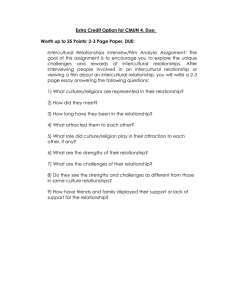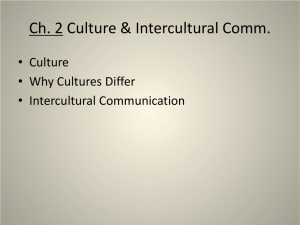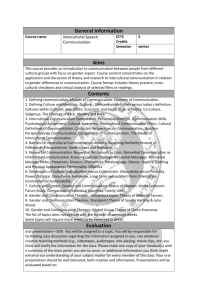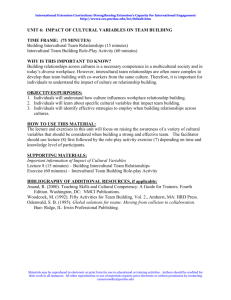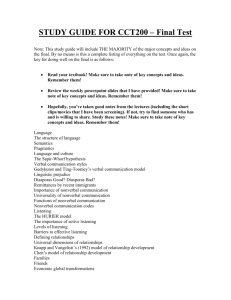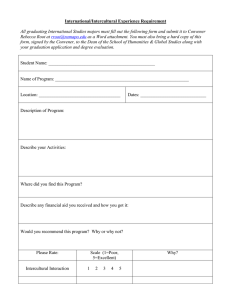2004.52 - COM 459 Intercultural Communication II (addition)
advertisement
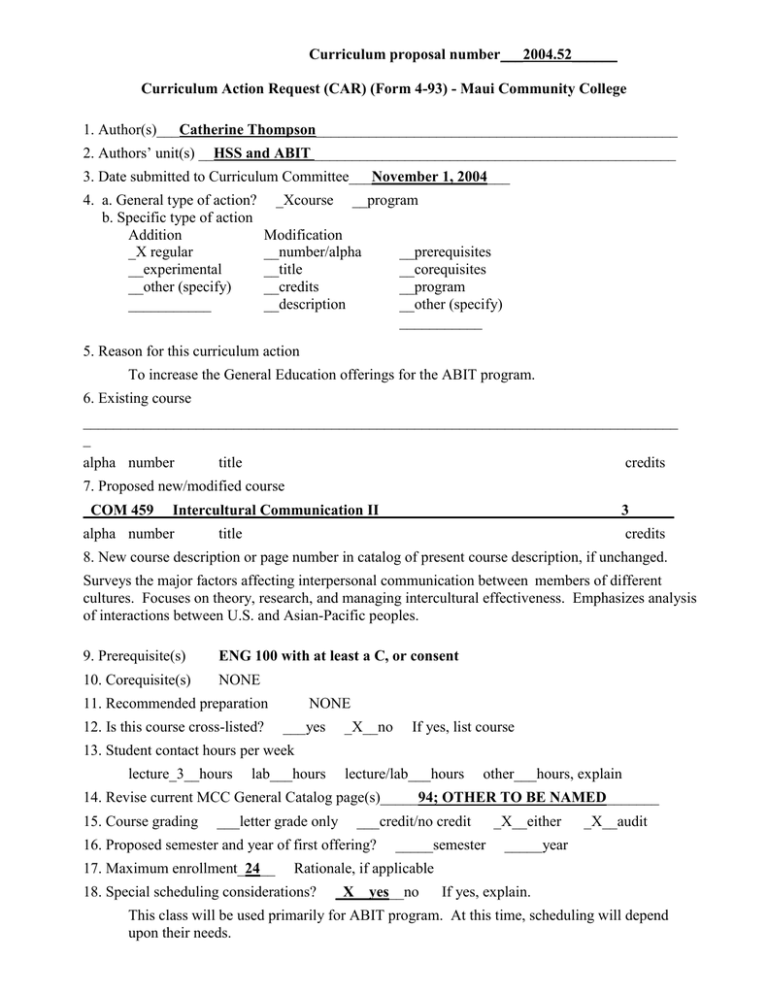
Curriculum proposal number___2004.52______ Curriculum Action Request (CAR) (Form 4-93) - Maui Community College 1. Author(s)___Catherine Thompson________________________________________________ 2. Authors’ unit(s) __HSS and ABIT ________________________________________________ 3. Date submitted to Curriculum Committee___November 1, 2004___ 4. a. General type of action? b. Specific type of action Addition _X regular __experimental __other (specify) ___________ _Xcourse __program Modification __number/alpha __title __credits __description __prerequisites __corequisites __program __other (specify) ___________ 5. Reason for this curriculum action To increase the General Education offerings for the ABIT program. 6. Existing course _______________________________________________________________________________ _ alpha number title credits 7. Proposed new/modified course _COM 459 Intercultural Communication II alpha number _______________________ ____3______ title credits 8. New course description or page number in catalog of present course description, if unchanged. Surveys the major factors affecting interpersonal communication between members of different cultures. Focuses on theory, research, and managing intercultural effectiveness. Emphasizes analysis of interactions between U.S. and Asian-Pacific peoples. 9. Prerequisite(s) ENG 100 with at least a C, or consent 10. Corequisite(s) NONE 11. Recommended preparation 12. Is this course cross-listed? NONE ___yes _X__no If yes, list course 13. Student contact hours per week lecture_3__hours lab___hours lecture/lab___hours other___hours, explain 14. Revise current MCC General Catalog page(s)_____94; OTHER TO BE NAMED_______ 15. Course grading ___letter grade only ___credit/no credit 16. Proposed semester and year of first offering? 17. Maximum enrollment_24__ _____semester _X__either _X__audit _____year Rationale, if applicable 18. Special scheduling considerations? _X_ yes__no If yes, explain. This class will be used primarily for ABIT program. At this time, scheduling will depend upon their needs. 19. Special fees required? __yes _X_no If yes, explain. 20. Will this request require special resources (personnel, supplies, etc.?) __yes _X_no If yes, explain. 21. Is this course restricted to particular room type? _X_yes __no If yes, explain. Room with movable chairs so that students can work in groups. Room with up to date media equipment for presentations, videos, etc. 22. _X_Course fulfills requirement for ______________ABIT_____________ program/degree __Course is an elective for __________________________________ program/degree _X_Course is elective for AA degree 23. This course __increases __decreases _X_makes no change in number of credits required for the program(s) affected by this action 24. Is this course taught at another UH campus? _X_yes __no a. If yes, specify campus, course, alpha and number UH Manoa, SP 385 UH Manoa, COM UH Hilo, COM 459 b. If no, explain why this course is offered at MCC 25. a. Course is articulated at __UHCC __UH Manoa __UH Hilo __UH WO __Other/PCC b. Course is appropriate for articulation at __UHCC _X_UH Manoa _X_UH Hilo _X_UH WO __Other/PCC c. Course is not appropriate for articulation at __UHCC __UH Manoa __UH Hilo __UH WO __Other/PCC d. Course articulation information is attached? __yes _X_no ....................................................................... Proposed by Approved by ________________________________ Author or Program Coordinator/Date _________________________________ Academic Senate Chair/Date Requested by _________________________________ Division or Unit Chair/Date _________________________________ Chief Academic Officer/Date Recommended by _________________________________ Curriculum Chair/Date Revised July 2004/AC _________________________________ Chancellor/Date Maui Community College Course Outline 1. Alpha and Number Communication 459 COM 459 2. Course Title Intercultural Communication II Credits 3 Date of Outline January 21, 2003 (Updated September 30, 2004) 3. Course Description Surveys the major factors affecting interpersonal communication between members of different cultures. Focuses on theory, research, and managing intercultural effectiveness. Emphasizes analysis of interactions between U.S. and Asian-Pacific peoples. 4. Contact Hours: 3 hours/lecture 5. Prerequisites English 100 with at least a C, or consent Corequisites none Recommended Preparation none Approved by _______________________________________Date__________________ 5. General Course Objectives: Generally, Communication 459 will help students become more competent in communication with others of diverse cultural backgrounds by helping them develop the following skills and understandings: Expanding one's range of verbal and nonverbal communication skills. More effective communicators have the ability to select and perform communication behaviors appropriate to various contexts. Becoming better able to acclimate to new environments. We all experience stress in ambiguous environments. More effective communicators recognize and handle that stress. Recognizing the influence one's own culture has had on the way in which one views oneself. More effective communicators understand how they became who they are and are less threatened by those of other backgrounds. Expanding one's knowledge of social customs of other cultures. More effective communicators understand how other cultures think and behave. 6. Student Learning Outcomes: For assessment purposes, these are linked to #7: Recommended Course Content On successful completion of this course, students will be able to a. identify and explain the relationship between culture and communication in intercultural interactions; define culture by examining a variety of definitions; identify and explain the characteristics of culture; define and explain subcultures; identify five classifications of subcultures; provide two examples of each classification; explain cultural universals and list the two types of classification systems studied; list two universals you think should be included, also; distinguish between human communication and intercultural communication; discuss the impact of encoding, decoding, messages, noise, and feedback in the intercultural communication process; list and explain eight common misconceptions about communication that could impact intercultural communication; explain why communication and culture are inseparable; describe the impact of culture on communication; distinguish among intracultural, interethnic, interracial, international, intercultural, and cross-cultural communication; identify and explain six reasons why we should study intercultural communication; identify one common characteristic of all definitions of culture and its categories; briefly explain the intercultural communication process and provide three situations involving intercultural communication; b. define perception and explain its function in intercultural communication; describe the selectivity process in perception; discuss 3 factors that influence selection; describe the role of organization in perception; discuss 3 ways people organize and perceive stimuli; describe the role of interpretation in perception; discuss 5 factors that can affect interpretation; c. explain the role of perception in communication; explain what one can do to increase perceptual accuracy; explain the roles of needs, values, beliefs, and attitudes in one's personal orientation system; define needs and explain the two types of needs; identify and compare Maslow's hierarchy of needs with Schutz' classification of interpersonal needs with regard to their usefulness cross-culturally; explain the implications of need satisfaction in intercultural communication; define values and explain their role in communication; identify and discuss the 6 major categories of common values across cultures; describe 2 rules related to values for intercultural interaction; define beliefs and describe 3 types of beliefs that are considered simple and useful; explain how these relate to reasoning cross-culturally? discuss worldview, its incumbent variables, and their impact on communication; define attitudes and explain their role in intercultural communication; define ethnocentrism, distinguishing between in-groups and out-groups, and list its two functions; define stereotyping and identify six characteristics of stereotypes; define prejudice and discuss the implications of the definition for intercultural communication; discuss the traditional forms of prejudice; provide an example for each form; discuss what we can do about prejudice in communication interactions; d. explain the role of language in intercultural communication; define language; briefly discuss 4 important elements of a language and their impact on intercultural communication; identify the most important element or characteristic of language, especially in intercultural communication and discuss it implications; identify and discuss the 4 types of meaning; identify and discuss 5 barriers related to meaning; explain the Sapir-Whorf hypothesis and its impact on communication; describe the Bernstein hypothesis; describe the role of context in communication; compare and contrast low- and high-context cultures; articulate the relationship between language and culture, include examples; e. distinguish between collectivist and individualist cultures and the implications for communication; compare and contrast the 6 major types of social institutions cross-culturally; discuss the ways societies structure relationships and how the structure can influence communication; differentiate between "independent construal of self" and "interdependent construal of self;" differentiate between high- and low-context cultures; provide at least five examples; f. analyze the role of nonverbal behavior in intercultural communication; define nonverbal behavior and discuss 4 characteristics of nonverbal behavior; discuss the nature of nonverbal behavior (the different types or classifications of nonverbal behaviors); describe 4 ways to suggest immediacy nonverbally; explain the role of nonverbal behavior in intercultural communication; describe why it would be important to take into consideration both intentional and unintentional forms of nonverbal communication when communicating interculturally; justify the statement that "culture is primarily a nonverbal phenomenon;" differentiate between individualism and collectivism as they refer to dimensions of nonverbal communication and culture; g. describe how can culture influence our perceptions of appropriate and effective communication; define and explain appropriate and effective communication; analyze and describe how nondominant U.S. cultures such as women, African Americans, people with disabilities, gays and lesbians, and the elderly are kept from obtaining equality, power, and respect by the "dominating culture;" identify suggestions one can give for communicating with members of nondominant U. S. cultures; explain any suggestions that hold true for all of the cultures; explain what nondominant cultures such as women, African Americans, people with disabilities, gays and lesbians, and the elderly have in common? briefly describe the value systems in the U.S. and Japan that affect business practices in each country; discuss the relationship between the cultural values and histories of the different countries; define and discuss the importance of the Japanese concept of "face;" h. identify and demonstrate skills that can enhance intercultural communication effectiveness define cultural or culture shock; identify and describe the 6 stages of cultural shock; describe the effects of cultural shock; discuss how to cope with cultural shock; define acculturation and describe the acculturation process; discuss 6 stumbling blocks to effective intercultural communication; 7. Recommended Course Content and Approximate Time Spent on Each Topic Linked to #6: Student Learning Outcomes. 1-3 weeks 2-3 weeks 2-3 weeks 2-3 weeks 2-3 weeks 1-2 weeks Culture and Communication (a) The Roles of Perception, Needs, and Values in Communication (b) Personal Orientation System (b, c) Social Institutions, Social Relationships, and Language (d, e) Nonverbal Communication, Barriers to Effective Communication and Improving Intercultural Communication (f, g, h) Culture Shock (h) 8. Text and Materials, Reference Materials, Auxiliary Materials and Content Appropriate text(s) and materials will be chosen at the time the course is offerred from those currently available in the field. Examples include Samovar, L. A., & Porter, R. E. (2003). Intercultural communication: A reader, (10th Ed.). Belmont, CA: Wadsworth/Thomson Learning. Jandt, F. E. (2002). Intercultural communication: An Introduction. (2nd Ed.) Thousand Oaks, CA: Sage Publications, Inc. Materials: Text(s) may be supplemented with articles and/or handouts prepared by the instructor; internet research; and library research. Other: Films and videos Guest speakers 9. Recommended Course Requirements and Evaluation Specific course requirements are at the discretion of the instructor at the time the course is being offered. Suggested requirements might include, but are not limited to 25 - 40 % 10 - 30 % 0 - 20 % 0 - 20 % 10 - 30 % 0 - 30 % 0 - 30 % 20 - 30 % 15 - 30 % 0 - 10 % Written and/or oral examinations In-class exercises Homework assignments Quizzes Journal entries Case studies Interviews Group projects (written and oral class presentations) Research and/or application paper (written and oral class presentations) Attendance and/or class participation 10. Methods of Instruction: Instructional methods will vary considerably with instructors. Specific methods will be at the discretion of the instructor teaching the course and might include, but are not limited to Lectures Quizzes and other tests with feedback and discussion In-class exercises, including but not limited to games and simulations Class discussions Guest lectures Audio, visual or mediated presentations including films/videos Student class presentations Group or individual projects Service Learning Assessment of Intended Student Learning Outcomes Standards COM 459 Standard 1 - Written Communication Outcome 1.1 - Use writing to discover and articulate ideas. 3 Outcome 1.2 - Identify and analyze the audience and purpose for any intended communication. 3 Outcome 1.3 - Choose language, style, and organization appropriate to particular purposes and audiences. 3 Outcome 1.4 - Gather information and document sources appropriately. 3 Outcome 1.5 - Express a main idea as a thesis, hypothesis, or other appropriate statement. 3 Outcome 1.6 - Develop a main idea clearly and concisely with appropriate content. 3 Outcome 1.7 - Demonstrate a mastery of the conventions of writing, including grammar, spelling, and mechanics. 3 Outcome 1.8 - Demonstrate proficiency in revision and editing. 3 Outcome 1.9 - Develop a personal voice in written communication. 3 Standard 2 - Quantitative Reasoning COM 459 Outcome 2.1 - Apply numeric, graphic, and symbolic skills and other forms of quantitative reasoning accurately and appropriately. 1 Outcome 2.2 - Demonstrate mastery of mathematical concepts, skills, and applications, using technology when appropriate. 0 Outcome 2.3 - Communicate clearly and concisely the methods and results of quantitative problem solving. 0 Outcome 2.4 - Formulate and test hypotheses using numerical experimentation. 0 Outcome 2.5 - Define quantitative issues and problems, gather relevant information, analyze that information, and present results. 0 Outcome 2.6 - Assess the validity of statistical conclusions. 1 Standard 3 - Information Retrieval and Technology COM 459 Outcome 3.1 - Use print and electronic information technology ethically and responsibly. 2 Outcome 3.2 - Demonstrate knowledge of basic vocabulary, concepts, and operations of information retrieval and technology. 1 Outcome 3.3 - Recognize, identify, and define an information need. 2 Outcome 3.4 - Access and retrieve information through print and electronic media, evaluating the accuracy and authenticity of that information. 3 Outcome 3.5 - Create, manage, organize, and communicate information through electronic media. 1 Outcome 3.6 - Recognize changing technologies and make informed choices about their appropriateness and use. 1 Standard 4 - Oral Communication COM 459 Outcome 4.1 - Identify and analyze the audience and purpose of any intended communication. 3 Outcome 4.2 - Gather, evaluate, select, and organize information for the communication. 3 Outcome 4.3 - Use language, techniques, and strategies appropriate to the audience and occasion. 3 Outcome 4.4 - Speak clearly and confidently, using the voice, volume, tone, and articulation appropriate to the audience and occasion. 3 Outcome 4.5 - Summarize, analyze, and evaluate oral communications and ask coherent questions as needed. 3 Outcome 4.6 - Use competent oral expression to initiate and sustain discussions. 3 Standard 5 - Critical Thinking COM 459 Outcome 5.1 - Identify and state problems, issues, arguments, and questions contained in a body of information. 3 Outcome 5.2 - Identify and analyze assumptions and underlying points of view relating to an issue or problem. 3 Outcome 5.3 - Formulate research questions that require descriptive and explanatory analyses. 2 Outcome 5.4 - Recognize and understand multiple modes of inquiry, including investigative methods based on observation and analysis. 3 Outcome 5.5 - Evaluate a problem, distinguishing between relevant and irrelevant facts, opinions, assumptions, issues, values, and biases through the use of appropriate evidence. 3 Outcome 5.6 - Apply problem-solving techniques and skills, including the rules of logic and logical sequence. 3 Outcome 5.7 - Synthesize inform from various sources, drawing appropriate conclusions. 3 Outcome 5.8 - Communicate clearly and concisely the methods and results of logical reasonong. 3 Outcome 5.9 - Reflect upon and evaluate their thought processes, value system, and world views in comparison to those of others. 3
